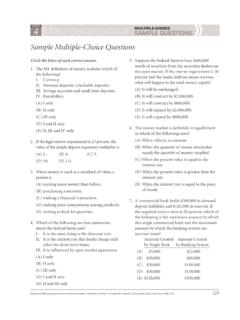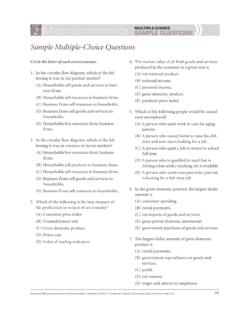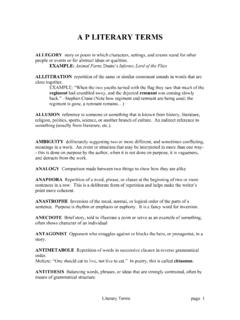Transcription of UNIT 3 Macroeconomics SAMPLE QUESTIONS MULTIPLE …
1 unit . 3 Macroeconomics MULTIPLE -CHOICE. SAMPLE QUESTIONS . SAMPLE MULTIPLE -Choice QUESTIONS Circle the letter of each correct answer. 4. A rightward shift in the aggregate demand curve with a horizontal aggregate supply curve will 1. Which of the following best describes aggregate cause employment and the price level to change supply? in which of the following ways? (A) The amount buyers plan to spend on Employment Price Level output (A) Increase Increase (B) A schedule showing the relationship (B) Increase Decrease between inputs and outputs (C) Increase No change (C) A schedule showing the trade-off between (D) Decrease No change inflation and unemployment (E) No change No change (D) A schedule indicating the level of real out- put that will be purchased at each possible 5.
2 An increase in the capital stock will cause the price level (A) aggregate demand curve to shift leftward. (E) A schedule indicating the level of real out- (B) production possibilities curve to shift in. put that will be produced at each possible (C) Phillips curve to shift out. price level (D) long-run aggregate supply curve to shift rightward. 2. A change in which of the following will cause (E) consumption function to shift down. the aggregate demand curve to shift? (A) Energy prices 6. Which of the following is a fiscal policy that (B) Productivity rates would increase aggregate demand in the Keyne- sian model? (C) Consumer wealth (A) A decrease in personal income taxes (D) Prices of inputs (B) A decrease in government spending (E) Prices of consumer goods (C) An increase in corporate income taxes (D) A purchase of government bonds by the 3.
3 The short-run aggregate supply curve will shift Federal Reserve to the right when (E) A sale of government bonds by the Federal (A) energy prices increase. Reserve (B) government regulation increases. (C) prices of inputs decrease. (D) investment spending decreases. (E) productivity rates decrease. Advanced Placement Economics Macroeconomics : Student Activities National Council on Economic Education, New York, 163. unit . 3 Macroeconomics MULTIPLE -CHOICE. SAMPLE QUESTIONS (continued). 7. An increase in labor productivity would most like- 10. In the Keynesian aggregate-expenditure model, ly cause real gross domestic product and the price the simple spending multiplier can be calculat- level to change in which of the following ways?
4 Ed by dividing Real GDP Price Level (A) the initial change in spending by the change (A) Increase Increase in real gross domestic product (GDP). (B) Increase Decrease (B) the change in real gross domestic product (C) Increase No change by the initial change in spending. (D) Decrease Increase (C) one by one minus the marginal propensity (E) Decrease No change to save. (D) one by one plus the marginal propensity to 8. If Maria Escalera's disposable income increases consume. from $600 to $650 and her level of personal- (E) the propensity to save by the propensity to consumption expenditures increase from $480. consume. to $520, you may conclude that her marginal propensity to 11. Which of the following will cause the (A) consume is consumption schedule to shift upward?
5 (B) consume is (A) An increase in the amount of consumer (C) consume is indebtedness (D) save is (B) A reduction in the wealth or assets held by (E) save is consumers (C) An expectation of future declines in the 9. In the Keynesian aggregate-expenditure model, if consumer price index the MPC is and gross investment increases (D) An expectation of future shortages of by $6 billion, equilibrium GDP will increase by essential consumer goods (A) $6 billion. (E) A growing belief that personal income will (B) $8 billion. decline in the future (C) $12 billion. 12. The investment demand curve will shift to the (D) $24 billion. right as the result of (E) $42 billion. (A) excess productive capacity. (B) an increase in corporate business taxes.
6 (C) businesses becoming more optimistic with respect to future business conditions. (D) recessions in foreign nations that trade with the United States, causing a lower demand for products. (E) a decrease in the real interest rate. 164 Advanced Placement Economics Macroeconomics : Student Activities National Council on Economic Education, New York, unit . 3 Macroeconomics MULTIPLE -CHOICE. SAMPLE QUESTIONS (continued). 13. Automatic stabilizers in the economy include 16. In which of the following ways will increases in which of the following? short-run aggregate supply change the price I. A progressive personal income tax level and unemployment? II. Unemployment compensation Price Level Unemployment III.
7 Congressional action that increases tax (A) Increase No change rates (B) Decrease Decrease (A) I only (C) Decrease Increase (B) II only (D) Decrease No change (C) III only (E) No change Increase (D) I and II only 17. Assume the aggregate supply curve is upward (E) I and III only sloping and the economy is in a recession. If the government increases both taxes and gov- 14. In order to be called an automatic, or built-in, ernment spending by $25 billion, the price stabilizer, which of the following must taxes level and real GDP will most likely change in automatically do in a recessionary period and which of the following ways? in an inflationary period? Price Level Real GDP. Recessionary Period Inflationary Period (A) Increase Increase (A) Decrease Decrease (B) Increase Decrease (B) Decrease Increase (C) Increase No Change (C) Increase Decrease (D) Decrease Decrease (D) Increase Increase (E) Decrease No Change (E) No change No change 15.
8 The balanced-budget multiplier indicates that (A) equal increases in government spending and taxation will make a recession worse. (B) equal increases in government spending and taxation will increase total spending. (C) government deficits might have a contrac- tionary impact on the economy. (D) supply will necessarily create its own demand. (E) the level of gross domestic product is never less than the level of disposable income. Advanced Placement Economics Macroeconomics : Student Activities National Council on Economic Education, New York, 165. unit . 3 Macroeconomics MULTIPLE -CHOICE. SAMPLE QUESTIONS (continued). C+I+G. C+I. $800 C. AGGREGATE EXPENDITURE. 600. (in billions). 400. 200. 150.
9 125. 75. 45 . 0. $200. $300. $400. $500. $600. $800. TOTAL INCOME. Use the information in the graph above to answer 19. In the graph, if full-employment GDP is $800. QUESTIONS 18, 19 and 20. Assume a closed economy billion, the minimum increase in autonomous with no tax function. expenditures that would be required to move total income to full employment income is 18. Which of the following are true statements (A) $200 billion. about total income? (B) $100 billion. I. Equilibrium total income is $800 billion. (C) $50 billion. II. Planned investment is $50 billion. III. Equilibrium aggregate expenditure is $600 (D) $25 billion. billion. (E) zero because total income is already at full (A) I only employment.
10 (B) II only 20. In the graph, the values of the MPC, MPS and (C) III only simple-expenditure multiplier are (D) I and III only MPC MPS Multiplier (E) II and III only (A) (B) (C) (D) (E) 166 Advanced Placement Economics Macroeconomics : Student Activities National Council on Economic Education, New York, unit . 3 Macroeconomics MULTIPLE -CHOICE. SAMPLE QUESTIONS (continued). 21. Which of the following fiscal policy actions 24. A severe, sustained increase in oil prices would would be most effective in combating a most likely cause short-run and long-run recession? aggregate supply curves and the production Government possibilities curve to change in which of the Taxes Spending following ways? (A) $25 billion decrease $25 billion decrease Short-Run Long-Run Production Aggregate Aggregate Possibilities (B) $25 billion decrease $25 billion increase Supply Curve Supply Curve Curve (C) $25 billion decrease No change (A) Decrease No change Shift outward (D) $25 billion increase $25 billion decrease (B) Decrease Decrease Shift outward (E) $25 billion increase $25 billion increase (C) Decrease Decrease Shift inward (D) Increase No change No change 22.










